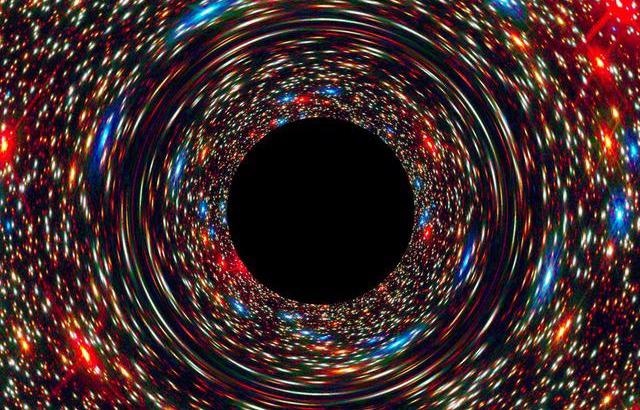Jan 22 2021
A new research work proposes the prospective occurrence of “stupendously large black holes” (SLABS), which are much larger than the supermassive black holes (SMBHs) already spotted at the centers of galaxies.
 This computer-simulated image shows a supermassive black hole at the core of a galaxy. The black region in the center represents the black hole’s event horizon, where no light can escape the massive object’s gravitational grip. The black hole’s powerful gravity distorts space around it like a funhouse mirror. Light from background stars is stretched and smeared as the stars skim by the black hole. Image Credit: NASA, ESA, and D. Coe, J. Anderson, and R. van der Marel (STScI).
This computer-simulated image shows a supermassive black hole at the core of a galaxy. The black region in the center represents the black hole’s event horizon, where no light can escape the massive object’s gravitational grip. The black hole’s powerful gravity distorts space around it like a funhouse mirror. Light from background stars is stretched and smeared as the stars skim by the black hole. Image Credit: NASA, ESA, and D. Coe, J. Anderson, and R. van der Marel (STScI).
Led by Queen Mary Emeritus Professor Bernard Carr from the School of Physics and Astronomy, in collaboration with F. Kühnel (Münich) and L. Visinelli (Frascati), the study analyzed how these SLABs could form and possible limits to their size.
Although there is evidence of the occurrence of SMBHs in galactic nuclei—that have masses ranging from 1 million to 10 billion times that of the Sun—earlier research works have proposed an upper limit to their size because of the existing view on how such black holes form and develop.
The occurrence of SLABS much larger than this could offer researchers a robust tool for cosmological tests and enhance our understanding of the early Universe.
Challenging Existing Ideas
Scientists have widely considered that SMBHs form inside a host galaxy and develop to their large sizes by gobbling stars and gas from their surroundings or by merging with other black holes. In such cases, there is an upper limit, a little more than 10 billion solar masses, on their mass.
In this research, the researchers suggest another likelihood for how SMBHs could form, which might bypass this limit. They propose that such SLABs could be “primordial,” having formed in the early Universe, and well ahead of galaxies.
Since “primordial” black holes do not tend to form from a collapsing star, they could have an extensive range of masses, such as very small and tremendously large ones.
We already know that black holes exist over a vast range of masses, with a SMBH of four million solar masses residing at the centre of our own galaxy. Whilst there isn’t currently evidence for the existence of SLABs, it’s conceivable that they could exist and they might also reside outside galaxies in intergalactic space, with interesting observational consequences. However, surprisingly, the idea of SLABs has largely been neglected until now.
Bernard Carr, Emeritus Professor, School of Physics and Astronomy, Queen Mary University of London
“We’ve proposed options for how these SLABs might form, and hope that our work will begin to motivate discussions amongst the community,” added Professor Carr.
Understanding Dark Matter
Dark matter is considered to constitute nearly 80% of the standard mass of the Universe. Although it cannot be seen, scientists contemplate that dark matter occurs due to its gravitational effects on visible matter, like galaxies and stars. But it is still not known what the dark matter exactly is.
Primordial black holes are one of the prospective candidates. The concept of their occurrence can be traced back to the 1970s when Professor Carr and Professor Stephen Hawking proposed that in the initial moments of the Universe, variations in its density could have led to the collapse of certain regions into black holes.
SLABs themselves could not provide the dark matter, but if they exist at all, it would have important implications for the early Universe and would make it plausible that lighter primordial black holes might do so.
Bernard Carr, Emeritus Professor, School of Physics and Astronomy, Queen Mary University of London
Journal Reference:
Carr, B., et al. (2021) Constraints on stupendously large black holes. Monthly Notices of the Royal Astronomical Society. doi.org/10.1093/mnras/staa3651.